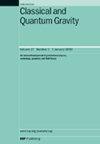从随机引力波背景加速推断双黑洞种群
IF 3.7
3区 物理与天体物理
Q2 ASTRONOMY & ASTROPHYSICS
引用次数: 0
摘要
第三代地面引力波探测器有望每年观测到来自众多天体物理源的重叠信号,这些信号将在计算上具有挑战性,难以单独解决。另一方面,由整个源种群产生的随机背景编码有关潜在种群的信息,允许种群参数推断独立并与单独解决的事件获得的推断互补。在这种情况下,参数估计在计算上仍然具有挑战性,因为计算功率谱涉及到描述二进制总体的每组超参数的采样源。在这项工作中,我们建立在最近开发的重要采样技术的基础上,有效地计算随机引力波背景(SGWB),并训练神经网络来插值得到的背景。我们证明了多层感知器可以对模型信息进行编码,从而大大加快了推理速度。我们假设具有CE和ET灵敏度的观测设置来测试网络,其中我们首次在推理中包含SGWB的固有方差,因为在这种设置中,它呈现出测量噪声的主要来源。本文章由计算机程序翻译,如有差异,请以英文原文为准。
Accelerated inference of binary black-hole populations from the stochastic gravitational-wave background
Third-generation ground-based gravitational wave detectors are expected to observe of overlapping signals per year from a multitude of astrophysical sources that will be computationally challenging to resolve individually. On the other hand, the stochastic background resulting from the entire population of sources encodes information about the underlying population, allowing for population parameter inference independent and complementary to that obtained with individually resolved events. Parameter estimation in this case is still computationally challenging, as computing the power spectrum involves sampling sources for each set of hyperparameters describing the binary population. In this work, we build on recently developed importance sampling techniques to compute the stochastic gravitational-wave background (SGWB) efficiently and train neural networks to interpolate the resulting background. We show that a multi-layer perceptron can encode the model information, allowing for significantly faster inference. We test the network assuming an observing setup with CE and ET sensitivities, where for the first time we include the intrinsic variance of the SGWB in the inference, as in this setup it presents a dominant source of measurement noise.
求助全文
通过发布文献求助,成功后即可免费获取论文全文。
去求助
来源期刊

Classical and Quantum Gravity
物理-天文与天体物理
CiteScore
7.00
自引率
8.60%
发文量
301
审稿时长
2-4 weeks
期刊介绍:
Classical and Quantum Gravity is an established journal for physicists, mathematicians and cosmologists in the fields of gravitation and the theory of spacetime. The journal is now the acknowledged world leader in classical relativity and all areas of quantum gravity.
 求助内容:
求助内容: 应助结果提醒方式:
应助结果提醒方式:


